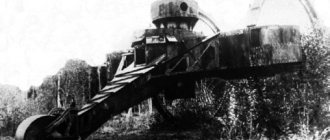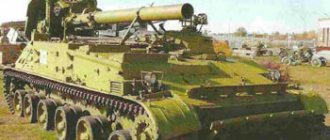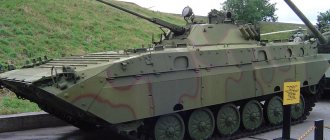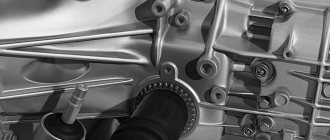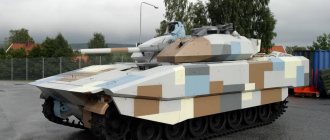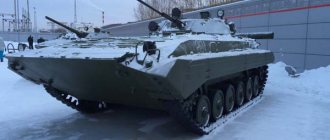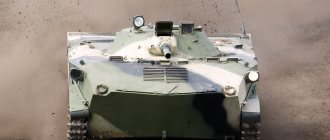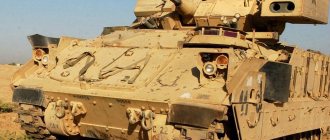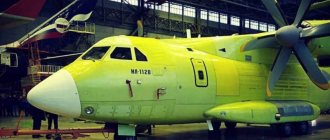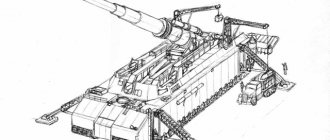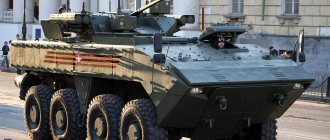BMP "Kurganets 25" at the Victory Parade on May 9, 2015 On May 9, 2015, during the military parade in Moscow dedicated to the seventieth anniversary of the victory in the Great Patriotic War, several previously unknown types of armored vehicles were demonstrated for the first time. One of the most notable new products was the Kurganets 25 infantry fighting vehicle, which was not similar in appearance to either its “predecessors” or their foreign counterparts. The developers of this promising infantry fighting vehicle, talking with journalists, noted that they were able to provide a very high level of protection against all modern weapons. The impression from the Kurganets was quite strong, but years passed, and this vehicle never entered service with the ground forces. Recently, a new deadline was announced for the adoption of the new infantry fighting vehicle into service, but there is every reason to assume that this time the goal will not be achieved.
History of the development of the Kurganets infantry fighting vehicle
The Soviet army, which disappeared along with the USSR, left behind a rich and varied armored “legacy”. There were three types of main battle tanks alone. Nothing like this has been observed in any other country in the world. In addition, BMP-1, BMP-2, BMP-3, BMD and many different auxiliary vehicles created on their basis were simultaneously operated. The need for unification and transition to some kind of single platform was obvious even then, but in the conditions of the collapse of the economy, this was impossible to do.
BMP-2, destroyed during the “New Year’s assault” on Grozny on the night of January 1, 1995
An additional incentive for the development of light armored vehicles was the military operations in Chechnya, which were accompanied by heavy losses and showed how vulnerable Russian armored personnel carriers and infantry fighting vehicles are. Already in 1995, the Main Armored Directorate (GABTU) prepared technical specifications for the development of several types of armored combat vehicles on a single platform, which was then considered the promising T-95 tank. This project, which received the code name “One-Volume Book,” lasted until the beginning of the 2000s, but apparently the matter did not go beyond sketches and drawings.
In 2004, information was leaked to the press that at the Kurganmashzavod enterprise, where the BMP-2 and BMP-3 are produced, design work was underway, the purpose of which was to provide the army with new infantry fighting vehicles and tracked armored personnel carriers, created on a single unified base. Even drawings were published depicting the future Kurganets 25 infantry fighting vehicle. At the same time, there was no reliable data for a long time, which was explained by the increased level of secrecy. As a result, doubts arose about the very existence of the new car, which were finally dispelled only shortly before its official presentation.
The first official photograph of the Kurganets-25 infantry fighting vehicle. Distributed by the Ministry of Defense shortly before the display at the parade
Having “shone” at the parade, “Kurganets” nevertheless has not yet entered the army, despite its successful testing in Syria in real combat conditions. One of the reasons for such a long period of “fine-tuning” the BMP is the deplorable state of the Kurganmashzavod. The only Russian enterprise of its kind has been teetering on the brink of bankruptcy for several years now. What adds piquancy to this situation is the fact that Albert Bakov, who led Kurganmashzavod until 2022, was himself declared uncreditworthy - his personal debts reached almost 80 million rubles. In addition, the enterprise is formally owned by Dutch investors, which, to put it mildly, is very strange for a company that is part of the defense complex.
In July 2022, the Russian Ministry of Defense entered into a contract with Kurganmashzavod for the supply of the first production batch of the Kurganets infantry fighting vehicle. The validity period of this agreement is 2022. It is difficult to say what will come of this, given that the company failed an earlier contract for the modernization of the BMP-3, despite a personal order from the president of the country.
Work on Russian B-19 combat vehicles with the 32B01 "Epoch" combat module
The Russian Ministry of Defense has agreed on a program for modernization and testing of B-19 infantry fighting vehicles. During the modernization, Russian B-19 infantry fighting vehicles will receive the Epoch combat module. This was reported by the Izvestia news agency, citing its own sources in the domestic defense department.
The Russian defense department recognized the successful participation of a platoon of B-19 infantry fighting vehicles with a 32B01 “Epoch” combat module in the command post strategic exercise “West-2021” at the Mulino training ground in the Nizhny Novgorod region.
Russian B-19 infantry fighting vehicles with the Epoch module during the Zapad-2021 exercise at the Mulino training ground in the Nizhny Novgorod region, NTV channel, September 2022
Allegedly, according to the scenario of the exercise episode, the combat vehicles, together with the Uran-9 combat robotic systems, provided fire support to the defending motorized rifle units. During the exercises, the combat vehicles successfully completed all assigned tasks.
Russian B-19 infantry fighting vehicles with the Epoch module during the Zapad-2021 exercise at the Mulino training ground in the Nizhny Novgorod region, September 2022
“An armored group consisting of a platoon of BMP B-19 was brought into battle with the main forces of the mock enemy reaching the front line of defense of units of military contingents of the armed forces of Belarus, India, Mongolia and the Russian Federation in order to increase the activity and stability of the defense during combat operations for the retention of important borders, positions and areas,” said representatives of the press service of the Ministry of Defense of the Russian Federation.
Now it is necessary to eliminate the identified shortcomings and carry out a partial modernization of the vehicle: communication systems, control systems and chassis. According to the work schedule available to Izvestia, it will cost about 26.5 million rubles. The modernization should be completed by the end of the year. After this, the new combat vehicle will continue testing again.
The B-19 infantry fighting vehicle is based on the BMP-3. Its first display took place in the form of a plastic model at the Army-2017 military-technical forum. The first ordered experimental batch of B-19 infantry fighting vehicles consists of 12 units and was actually delivered to the Ministry of Defense at the end of 2022.
Models of the B-19 infantry fighting vehicle with the remote-controlled module "Epoch" at the Army 2017 forum
One of the main differences between the B-19 and the BMP-3 is the TKB-973 Epoch (32B01) remote-controlled combat module, equipped with a 57-mm automatic cannon and Kornet and Bulat anti-tank guided missile systems. Its feature is the presence of an automated search system, recognition of enemy objects, their tracking and preparation, and the issuance of proposals to the crew of the combat vehicle for the simultaneous or alternate use of two fire channels. The development of the combat module was carried out by engineers from JSC Instrument Design Bureau named after. Academician A.G. Shipunov" (KBP, Tula).
Modernizing infantry fighting vehicles like the BMP-3 to the level of the B-19, by reworking the base, installing a new combat module and introducing high-tech sighting systems, means quickly raising the vehicle's characteristics to a level acceptable in modern combat operations, without waiting for the start of deliveries of promising models.
Russian infantry fighting vehicles BMP-3M, B-19 and B-11 "Kurganets-25"
The Russian Federation, according to the authoritative Western publication “The Military Balance,” has at least six hundred BMP-3 and more than two dozen BMP-3M as of 2022, the characteristics of which are gradually no longer consistent with modern armored vehicles. In addition, work on the promising B-11 Kurganets-25 infantry fighting vehicle continues to be delayed due to problems with the engines, which is at least evidenced by the fact that this infantry fighting vehicle has not appeared on the Army forum for two years.
This situation forces the Russian defense department to look for a new combat vehicle that is more or less modern in its characteristics, the production of which, if necessary, can be quickly and inexpensively established due to the use of units from existing vehicles.
If you find an error, please select a piece of text and press Ctrl+Enter.
Description of design
"Kurganets 25" is a platform on the basis of which you can assemble both an infantry fighting vehicle and an armored personnel carrier. This was achieved through the use of a modular principle. The version of the Kurganets 25 armored personnel carrier has the additional designation B10.
"Kurganets-25B10" - armored personnel carrier. The combat module is lightweight, a machine gun is installed instead of a cannon
The most significant design features of the new combat vehicle are the following details:
- The MTO (engine-transmission compartment) on the Kurganets is located in the front and is shifted to the right side relative to the longitudinal axis. Approximately the same solution was used to create the BMP-1 - the engine was located “in the nose”;
- The troop compartment is located at the rear of the vehicle and is equipped with a ramp and an additional door to speed up the disembarkation of soldiers;
- The ammunition is completely isolated from the places where people are located;
- Hydropneumatic suspension is used. It is possible to regulate the clearance, the maximum value of which reaches half a meter, the minimum value is 10 cm;
- The side protection of the vehicle can be strengthened by adding additional armor screens. In addition, floats can be mounted on top of them to overcome water obstacles. It was in this configuration that the BMP 4 “Kurganets” was demonstrated at the military parade.
The crew, consisting of a commander, gunner and driver, is housed in a special well-protected capsule, similar to the one installed on the Armata tank. Monitoring of the environment is carried out not only through the usual triplexes, but also with the help of video cameras.
Top view of the Kurganets-25 infantry fighting vehicle. Elements of the active protection complex are clearly visible - in the front part and on the sides of the combat module
To protect the vehicle from anti-tank grenades and shells, elements of the Afghanit active defense complex were used - small mortars capable of destroying incoming ammunition.
Forbes (USA): the project of the new generation combat vehicle “Kurganets-25” is “postponed indefinitely”
The modular unmanned turret "Epoch" has new weapons. The same turret is installed on other armored vehicles. The weapon system is represented by a 30-mm 2A4 cannon with a BMP-2 and four new Kornet-EM missiles, operating on a “fire and forget” principle. The laser-guided Kornet missile penetrates thicker armor, and these missiles can be launched faster than their predecessor, the wire-guided Konkurs complex. Thus, the new vehicle is much more dangerous for modern Western tanks.
The Kurganets was also planned to be equipped with laser and thermal sensors, a search-and-strike fire control system and the Afganit active defense system, which is designed to repel and intercept incoming anti-tank missiles.
In theory, the Kurganets was supposed to be a powerful and modern machine. But the Russian economy has suffered significant losses over the past six years due to a number of factors, including Western sanctions, falling oil prices and the covid-19 pandemic. This has already led to the postponement or cancellation of many defense programs.
These problems, as well as the schedule delays and shortcomings mentioned by Murakhovsky, were probably the reason why the project was shelved, at least for the near future.
Russia is by no means unique when it comes to the difficulties associated with integrating modern technologies and improving the armor protection of new infantry fighting vehicles. In January, the Pentagon restarted its program to develop a new infantry fighting vehicle to replace the Bradley, doing so for the third time in two decades and spending more than $20 billion on previous efforts.
What awaits Russian motorized riflemen?
Faced with delays and rising costs in the development of new ground warfare systems, the Russian Ministry of Defense is increasingly choosing to modernize older models rather than produce new ones, including, in particular, the purchase of hundreds of additional BMP-3 vehicles.
The military is especially interested in a modernized version of the BPM-3 called Manul, which is a development of the previously proposed BMP-3 Dragoon with a different turret.
"Manul" is called a transitional stage between the BMP-3 and the armored vehicles of the future. It is equipped with a UTD-32T engine with a power of 660 horsepower and technical characteristics improved by 32%. The engine is located in the front of the hull, which helps protect the crew and troops from penetrating hits. The troop compartment has become more spacious and can accommodate up to eight soldiers. It has a rear door with a ramp. It is much more convenient than the extremely bulky layout in the BMP-3.
photos of BMP-3M Manul IFV's interior, posted by user tankoff from otvaga2004 forum pic.twitter.com/SEqcQLqEyQ
— Artem Beliakov (@skylancer7441) August 28, 2020
The BMP-3 also has an uninhabited Epoch turret with Kornet-EM missiles, a 30mm cannon and a PKTM machine gun. However, the modernized vehicle lacks its very characteristic 100 mm cannon.
This model also has remote control systems and detection devices developed for Kurganets. However, the Manul, apparently, does not have as powerful armor throughout the hull as the Kurgan. The vehicle also lacks important improvements to protect against mines and improvised explosive devices, which pose one of the main threats to armored vehicles today. However, the Manul is a deeply modernized version in terms of anti-tank weapons, sensors, mobility, number of seats, ergonomics and survivability.
Russian BMP-3 "Manul" / BMP-3 "Manul" IFV variant pic.twitter.com/jiIgdeQwS3
— Caesar (@Ninja998998) August 28, 2020
There are also many other proposals for the creation of armored vehicles for transporting troops, which are intended for different types of military units and for performing different tasks.
The most important new model may be the 8-wheeled Boomerang armored personnel carrier, which should eventually replace the huge fleet of Soviet-era armored personnel carriers. The Boomerang can be equipped with the same Epoch turret as the Kurganets and Manul, and it will replace armored personnel carriers from Russian motorized rifle units.
Another project is the T-15 Armata, which is a more heavily armored version of the T-14. It is a “heavy infantry fighting vehicle” with tank-level armor protection. It is designed for combat in urban environments and other difficult environments.
According to available information, T-15s could make up about a third of the order for 132 Armatas. This is enough to equip a motorized rifle battalion supporting two such battalions with T-14s from a tank brigade.
Russian airborne troops are also receiving very light BMD-4M airborne combat vehicles, which can be parachuted from an aircraft. These vehicles, like the old BMP-3, are armed with 100 mm and 30 mm cannons.
Perhaps the Kurganets production program will be resumed over time. But the project's delay highlights the financial constraints and technical problems that are hampering Russia's ambitious military modernization project. And this is despite the furore caused by the appearance of impressive prototypes at the military parade in Moscow in 2015.
Specifications
"Kurganets" is a promising infantry fighting vehicle. It has not yet been adopted, which means that some of the vehicle’s characteristics may change over time. In addition, some of the information remains classified today. Based on the available information, the following table can be compiled:
| Maximum weight | 25 tons (according to other sources, 26) |
| Troop compartment capacity | 8 people |
| Crew | 3 persons |
| Height (maximum, with combat module and commander's sight) | 3.29 meters |
| Width | 3.2 meters |
| Length | 7.2 meters |
| Maximum speed | 80 km/h on land, 10 km/h on water |
| Power plant power | 800 hp (according to other sources – 750) |
The speed is most likely given for the armored personnel carrier version, and not the infantry fighting vehicle, however, the difference is unlikely to be very significant.
Advantages and disadvantages
The advantages of the Kurganets 25 infantry fighting vehicle include, first of all, a significantly increased level of security, achieved both through increased armor and through the use of elements of the Afganit complex.
BMP "Kurganets 25" during sea trials in rough terrain
The new infantry fighting vehicle has other advantages:
- Good maneuverability;
- Increased level of automation, which makes the gunner’s work much easier;
- Surveillance systems have been significantly improved;
- Unification has been achieved with an armored personnel carrier built on the same platform. Other variations should appear in the future, such as a self-propelled artillery unit;
- Mine protection has been noticeably enhanced.
It should be noted that for an infantry fighting vehicle weighing 25 tons, the Kurganets is very mobile, and the vehicle’s ride is quite smooth.
Unfortunately, there are also a lot of disadvantages:
- The dimensions of the Kurganets are very large. It is much easier to hit than older BMP models;
- The price of the vehicle is approximately five times higher than the cost of upgrading the BMP-3. This makes mass rearmament very problematic;
- The Kurganets' armament looks rather weak compared to the BMP-3, and it is unlikely to be strengthened;
- There are no side embrasures in the troop compartment, which greatly increases the threat from enemy grenade launchers approaching from the flank.
In addition, one can note a certain ambiguity in the very concept of the vehicle, because at the same time as the Kurganets, the T-15 BMP was also shown, made on the basis of the T-14 Armata tank and featuring a much higher level of protection.
T-15 BMP, armed with the same combat module as the Kurganets, but much more heavily armored
The adoption of both of these models will mean that instead of the intended unification, there will be an additional “multiplication of entities,” not to mention an excessive burden on the country’s budget.
Modern Russian armored vehicles: BMP with a toilet and a tank killer
BMP "Kurganets-25" / Photo: bastion-karpenko.ru
2015 in Russia became a premiere year for promising armored vehicles: combat vehicles based on the "Armata" and "Kurganets" platforms were shown at the Victory Parade, then at the Russian Arms Expo and promised at the next exhibition to demonstrate tanks and infantry fighting vehicles in action, with shooting. State tests of new equipment will begin in 2016, but already quite a lot is known about new infantry fighting vehicles, tanks and exotic vehicles of Uralvagonzavod.
Toilet in the stern
The Kurganets-25 infantry fighting vehicle is equipped with air purification systems, external video surveillance and a toilet, which allows the crew and troops not to leave the infantry fighting vehicle for several days. The Kurganets air conditioning unit is capable of operating in conditions of chemical, bacteriological and radiation contamination, supplying purified, breathable air to workplaces. Eight video cameras placed on the armor provide the crew with an overview of all approaches to the infantry fighting vehicle, and the hatch in the stern is equipped with a folding seat.
Photo: bastion-karpenko.ru
Photo: Vitaly Kuzmin
According to the first vice-president of the Tractor Plants concern Albert Bakov, the price of the Kurganets will be less than 300 million rubles. Now the developers are changing the profile of the vehicle to reduce its vulnerability - the first prototypes of the infantry fighting vehicle were nicknamed “the grenade launcher’s dream.” For the first time, the crew and troops of a combat vehicle are separated from the weapons and ammunition - this increases the chances of survival if an infantry fighting vehicle is hit by the enemy.
The Kurganets' weapons are concentrated in a robotic combat module. There is a 30mm automatic cannon, a machine gun and Kornet anti-tank missile launchers. The fire control system can independently track targets specified by the operator.
Unmanned BMP-3 / Photo: bmpd.livejournal.com
At RAE-2015, Kurgan tractor manufacturers also showed an unmanned BMP-3. The car was equipped with the Vityaz remote control system. “The machine has all-round cameras, and all actuators can be controlled remotely. The crew is only needed to load the cannon and protect the vehicle from nearby threats. For example, the task was set to “reach” a target located seven kilometers away. On the way to her, an infantry fighting vehicle was attacked. The landing party dismounts and repels the attack, and the vehicle continues to carry out its combat mission,” said a representative of the enterprise.
Unkillable modules
We went even further at Uralvagonzavod, the birthplace of the famous Armata. Inspired by the global triumph of the T-14 tank, factory workers are developing new variants of combat vehicles on the same platform - for example, a “tank killer” with a 152-mm gun - and plan with their help to change the tactics of modern warfare.
“Frontline equipment must have the same protection and mobility. If tanks and infantry fighting vehicles are in the same order, then at the next line, most likely, only tanks will remain. In this tactical zone there should be no easily hit vehicles at all,” says Vyacheslav Khalitov, Deputy General Director of UVZ. – It is necessary to move away from tank and motorized rifle platoons, creating instead autonomous systems such as combat modules capable of long-term combat operations. Each such unit can include 1-2 tanks, 3-4 heavy infantry fighting vehicles, a heavy attack vehicle with a 152-mm gun, capable of firing not only along artillery trajectories, but also at direct fire. In the RAE-2015 demonstration program, we showed such a module in action.”
T-14 "Armata", tank / Infographics: presented by InfoStep
For the module to fully operate, it also requires group defense vehicles capable of fighting robots, including miniature ones, on the ground and in the air. We need a control and reconnaissance vehicle, and for autonomy, a repair and support vehicle.
“Several of these modules are combined into a combat platform, giving it engineering support vehicles, electronic warfare and NBC protection. The result is an autonomous self-regulating structure capable of conducting combat operations. Multiple platforms are combined into a combat tactical platform, etc. I am sure that this concept has a future and the Russian army will definitely come to it,” Khalitov said.
Peaceful Russian tractor
The Chelyabinsk Tractor Plant showed an armored bulldozer at RAE. The B10M2 serial vehicle is equipped with enhanced protection of the cabin and units from stones, falling trees and other force majeure.
B10M2 / Photo: ic.pics.livejournal.com
At the request of the customer, the bulldozer cabin and engine compartment can be dressed in armor - then the tractor will become invulnerable to small arms and shrapnel.
Representatives of the Ministry of Emergency Situations and the Engineering Troops, as well as delegations from India, Iran and Kazakhstan, became interested in the new product.
MOSCOW, WEAPONS OF RUSSIA, Anton Ivanov www.arms-expo.ru 1
Armament
The Kurganets 25 infantry fighting vehicle is equipped with the Boomerang-BM universal combat module. It is controlled only remotely and is “uninhabited”. The module includes several types of weapons:
- Automatic cannon 2A42 caliber 30 mm. The ammunition supply is selective, you can switch between two different types of projectiles;
- Anti-tank missile system "Kornet". The launchers are placed in pairs on both sides, outside the combat module;
- PKTM machine gun 7.62 caliber. Ammunition - 2000 rounds.
For comparison, it should be noted that the 2A42 cannon was installed on the BMP-3 together with a powerful 100-mm gun, through the barrel of which anti-tank guided missiles could be launched.
Despite the fact that the automatic grenade launcher has proven itself to be an effective anti-personnel weapon, it was not included in the combat module for the Kurganets infantry fighting vehicle.
Combat module "Boomerang". The Kornet ATGM launchers and the 2A42 automatic cannon are clearly visible
Exploitation
Almost nothing is known about the experience of practical use of the new infantry fighting vehicle. Individual copies were sent to the troops for preliminary testing back in 2015-16. Based on the results of this inspection, it was said that the military did not like the too high profile of the Kurganets. However, the height of the car has not changed since then.
In the spring of 2022, a number of news agencies reported that Kurganets 25 had been spotted in Syria. However, no details were provided.
The Ministry of Defense intends to begin large-scale operation of this infantry fighting vehicle before the end of 2022, but this will only become possible if Kurganmashzavod does not miss the deadline for completing the necessary work.
